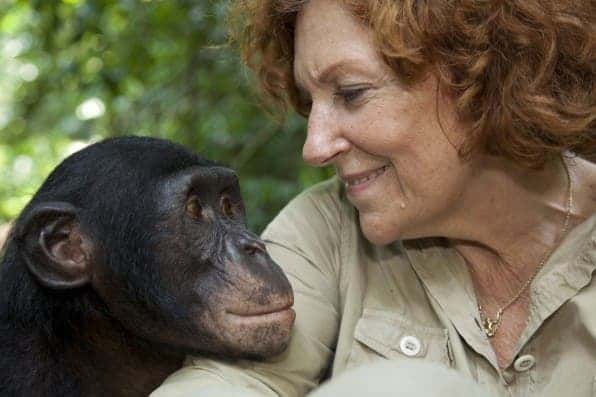A pair of anthropologists compared the anatomical features o bonobos to those of homo sapiens and other apes to infer any clues that might help us understand how we evolved to look the way we do.

Claudine Andre, the founder of Lola ya bonobo, and the “friends of the bonobos of the Congo’, an NGO which works in DRC with Timbo, one of her best bonobo friends. Photo courtesy of Christian Ziegler.
You might have seen those Neanderthal or Homo Erectus casts in a museum a bunch of times, only to wonder: “oh, so that’s how they look like.” Well, not entirely so. Remember, there’s no preserved tissue of any of our ancestors, some of whom lived as long ago as 2.8 million years ago (H. habilis). All the muscle, tissue or hair you see reconstructed in museums or documentaries are made by professional artists under the guidelines of biologists and anthropologists. Based on bone shape, wear and other features, we can roughly infer how other hominids might have look like, but that’s about it. There’s only so much you can tell from looking at fossils. There’s no tantalizing evidence pointing to how much body fat or muscles a typical Homo Erectus used to have, or what the organs looked like for that matter.
Adrienne L. Zihlmana of University of California, Santa Cruz and Debra R. Bolter of Modesto College, California sought to understand how we evolved anatomically as a species by looking at our closest relative: the bonobo (Pan paniscus). But as much as we’re strikingly similar, the bonobos differ from us in one important aspect: violence. While humans and the common chimpanzee wage war and kill each other, bonobos do not. “There has never been a recorded case in captivity or in the wild of a bonobo killing another bonobo,” notes anthropologist Brian Hare.
“We go to this sanctuary and we play these fun problem-solving games with them to just try and get inside their heads and figure out exactly how they think,” says Vanessa Woods, Hare’s colleague. “They’re wonderful animals to be related to. It’s a shame so few people have heard of them.”
To learn more about the bonobos, the two anthropologists dissected the bodies of 13 bonobos who died of natural causes over a period of thirty years. The researchers carefully took notes pertaining to their anatomical features, like fat and muscle percentage. Some key findings include: a lot less body fat than humans, even in those cases where the bonobos lived in captivity and were sedentary; more muscle mass in the upper body and less in the lower body, i.e. the legs; finally, bonobos have a lot more skin than humans.

Percentage of muscle distribution to upper and lower limbs in Pongo pygmaeus, Gorilla gorilla, P. paniscus, and H. sapiens. Credit: (c) Adrienne L. Zihlman
Now, since the bonobo is more of a cousin than an ancestor, what ca we learn from these anatomical features? Well, it’s safe to say that at some point the genus Homo and the genus Pan split from a common ancestor. With this in mind (and there’s quite a deal of speculations), the researchers suggest that the primary differences between humans and bonobos can be accounted to the crucial period when early humans began walking upright. This naturally called for more fat, more leg muscles, and less upperbody muscles. They also believe that we humans have less skin because as we moved around and moved faster on two legs—our skin developed an ability to sweat as a means to keep cool and that led to thinner skin, they report in Proceedings of the National Academy of Sciences. This “comparison of soft tissues between Pan and Homo provides new insights into the function and evolution of body composition,” the researchers write in the study abstract.









